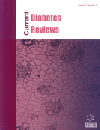- Home
- A-Z Publications
- Current Diabetes Reviews
- Previous Issues
- Volume 7, Issue 4, 2011
Current Diabetes Reviews - Volume 7, Issue 4, 2011
Volume 7, Issue 4, 2011
-
-
Diabetes and Cardiovascular Disease Following Kidney Transplantation
More LessAuthors: Brian P. Boerner, Vijay Shivaswamy, Cyrus V. Desouza and Jennifer L. LarsenKidney transplantation is being performed more frequently for individuals with end stage renal disease (ESRD) due to improved survival and quality of life compared to long-term dialysis. Though rates decrease after transplant, cardiovascular disease (CVD) remains the most common cause of death after kidney transplant. New-onset diabetes after transplant (NODAT), a common complication following kidney transplantation, a Read More
-
-
-
IGF-I Signaling in Response to Hyperglycemia and the Development of Diabetic Complications
More LessAuthors: David Clemmons, Laura Maile, Gang Xi, Xinchun Shen and Yashwanth RadhakrishnanIGF-I is structurally related to proinsulin and when administered to human subjects it enhances insulin sensitivity. However because of its growth promoting properties and its relationship to growth hormone, it has been proposed as a etiologic factor in the development of diabetic complications. This review discusses recently published data regarding the ability of hyperglycemia to sensitize cells that are capable of Read More
-
-
-
The Evidence for Automated Grading in Diabetic Retinopathy Screening
More LessAuthors: Alan D. Fleming, Sam Philip, Keith A. Goatman, Gordon J. Prescott, Peter F. Sharp and John A. OlsonSystematic screening for diabetic retinopathy using retinal photography has been shown to reduce the incidence of blindness among people with diabetes. The implementation of diabetic retinopathy screening programmes faces several challenges. Consequently, methods for improving the efficiency of screening are being sought, one of which is the automation of image grading involving detection of images with either dise Read More
-
-
-
Management of Exercise-induced Glycemic Imbalances in Type 1 Diabetes
More LessAuthors: Maria P. Francescato and Sergio CarratoRegular moderate-intensity exercise is strongly recommended for its beneficial effects in all people. In patients with type 1 diabetes, however, the exercise-associated glycemic imbalances remain an unresolved clinical challenge. Current guidelines require an in-depth understanding of the glycemic responses to exercise and each patient has to discover, by trial-and-error, his/her own strategy, several attempts being usually Read More
-
-
-
Heat Shock Response Regulates Insulin Sensitivity and Glucose Homeostasis: Pathophysiological Impact and Therapeutic Potential
More LessAuthors: Tatsuya Kondo, Saori Koga, Rina Matsuyama, Katsutoshi Miyagawa, Rieko Goto, Hirofumi Kai and Eiichi ArakiA large and increasing number of people in all over the world suffer from obesity, metabolic syndrome (MS) and type 2 diabetes mellitus (T2DM). Attenuation of the heat shock response (HSR), which was originally identified as a cellular defense mechanism, is one of the key factors involved in the deterioration of metabolic abnormalities. On the other hand, activating the HSR increases heat shock protein 72 (HSP72) expression Read More
-
-
-
Adipose Triglyceride Lipase: A New Target in the Regulation of Lipolysis by Insulin
More LessAuthors: Partha Chakrabarti and Konstantin V. KandrorIn adipose tissue, the primary physiological function of insulin is the suppression of lipolysis, the hydrolysis of stored fat. Mechanistically, insulin suppresses lipolysis both in transcriptional and post-transcriptional levels. Insulin signaling acutely inhibits beta-adrenergic signaling by decreasing intracellular cyclic AMP levels and the rate of lipolysis. Insulin also suppresses lipolysis by down-regulating the expression of the rate-limi Read More
-
-
-
The Role of Natural Killer T (NKT) Cells in the Pathogenesis of Type 1 Diabetes
More LessIn type 1 diabetes, a failure in the regulation of either innate or acquired immunity may be the cause of autoimmune response. A cell population that may have a regulatory role of the immune response are the Natural Killer T (NKT) cells, which are a population expressing T lymphocyte antigen receptor (TCR), and a common marker for NK cells. A distinctive characteristic in NKT cells is their capacity to produce large am Read More
-
-
-
The Extra-Hematopoietic Role of Erythropoietin in Diabetes Mellitus
More LessAuthors: Diana Choi, Ravi Retnakaran and Minna WooDiabetes mellitus is a complex metabolic disorder characterized by chronic hyperglycemia and vascular complications, leading to significant morbidity and mortality. All forms of diabetes are ultimately related to insufficient functional pancreatic β-cell mass to maintain euglycemia. In this context, the promotion of β-cell survival and function is a fundamental issue of direct relevance to diabetes prevention and treatment. A Read More
-
Volumes & issues
-
Volume 21 (2025)
-
Volume 20 (2024)
-
Volume 19 (2023)
-
Volume 18 (2022)
-
Volume 17 (2021)
-
Volume 16 (2020)
-
Volume 15 (2019)
-
Volume 14 (2018)
-
Volume 13 (2017)
-
Volume 12 (2016)
-
Volume 11 (2015)
-
Volume 10 (2014)
-
Volume 9 (2013)
-
Volume 8 (2012)
-
Volume 7 (2011)
-
Volume 6 (2010)
-
Volume 5 (2009)
-
Volume 4 (2008)
-
Volume 3 (2007)
-
Volume 2 (2006)
-
Volume 1 (2005)
Most Read This Month
Article
content/journals/cdr
Journal
10
5
false
en


